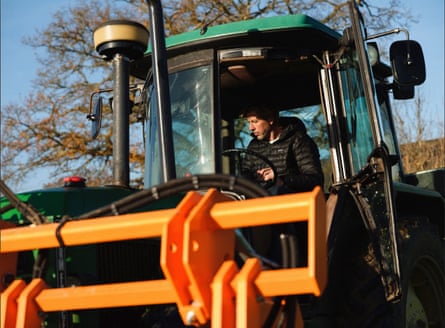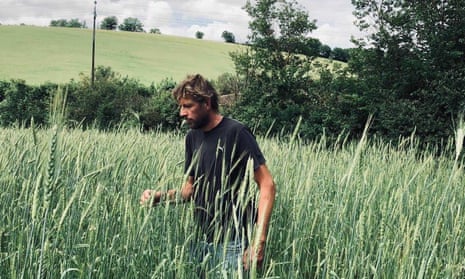On the way back from a gig 15 years ago, I read an article on the environmental consequences of food production. It made for sobering reading, and ended by saying: “If you don’t like the system, don’t depend on it.” I was inspired to transform our garden in France into a vegetable patch in a quest for self-sufficiency. This quickly escalated, and I ended up selling the rights to my songs with Groove Armada to buy a farm nearby. After 12 years in the agricultural school of hard knocks, what we learned there is now being applied on a National Trust farm near Swindon for which we were awarded the tenancy last year.
Back in France during last month’s heatwaves, the effect on the landscape was devastating. Spring-sown crops, hanging on after very little rainfall and unrelenting sun, will, for many, not be worth harvesting. Looking over the parched valley, veiled in wildfire smoke drifting up from the coast, I made a throwaway remark to some farming friends about planting olive trees to cope with increasingly regular episodes of intense, dry heat. One replied that there was in fact a meeting that evening about the creation of a Gascon olive oil collective. The shift in weather patterns over the past decade has been incredible. Farmers feel the effects immediately; we are gardening without a hosepipe.
Postwar farming practices have played a significant role in getting us here. Soil is by far the Earth’s biggest carbon store outside the oceans – it holds more than all the world’s plants and forests combined. Since the beginning of agriculture, soil has lost about 8% of its carbon, creating up to 20% of human-made CO2 emissions. Soil carbon is crucial for the retention of water. According to the US Department of Agriculture, this loss in carbon can translate to a loss of 800,000 litres per hectare of water storage. This makes crops prone to drought and increases devastation from flooding for communities downstream. Biodiversity loss, most visible on our bug-free windscreens and documented in endless falling graphs of insects, birds and life of all kinds, is a crisis as dramatic as the changing climate. It is inevitably linked to agriculture because farming covers 71% of UK land.
Done differently, farming has the potential to store carbon, house diverse wildlife and provide ample, nutritious food. Yet since the mid-20th century, western policy has pushed farmers in the opposite direction. Government-funded research, education and subsidies have been used to drive chemically intensive production over ever-larger acreages. Short-term yields had their most famous spokesperson in Nixon’s secretary of state for agriculture, Earl Butz, who ordered farmers to “get big or get out”.

To maximise efficiency of production, the farming landscape has become one of monocultures, with single crops across whole fields, areas or even regions. A single species of plant across a large area is something that never exists in nature because it’s incompatible with a healthy ecosystem. As such, it requires a constant battle against nature’s attempts to reintroduce diversity: the ceaseless removal of what we see as weeds, and the killing of insects whose job is to remove unhealthy plant growth, which is what chemically reliant crops are. In 1943, Albert Howard, the godfather of what is now called “regenerative” farming, wrote that “the appearance of a pest should be regarded as a warning from Mother Earth to put our house in order”.
Harvesting our food from the ecosystems that sustain us could be compared to extracting timber from a hillside forest. We have two choices. Our current choice is a short-term bumper harvest, levelling the forest and leaving the exposed soil to disappear with the rain. The other option is to preserve the forest’s integrity and manage it for timber over the long term. This would not only yield much more in time but would also maintain the habitat on which we depend. Farming within nature’s limits may yield less in a year, but it can do so indefinitely. Yields must be considered over the long term. With one-third of all food wasted and an epidemic of diet-related disease in the west, questions of yield are often used to obscure the real questions about food quality and distribution.
During the first 10,000 years of agriculture, humans produced food from polycultures, diverse groups of plants growing together, for almost all that time. Modern-day monocultures are an anomaly. Around the world, innovative farmers are finding ways to bring diversity back into our fields. A diversity of plants means a diversity of habitats, allowing wildlife to return. Different plant families growing together feed a diversity of soil life. Thriving soil communities feed and protect the plants, meaning there is no need to spray our food with toxic chemicals. Soil covered in a diversity of plants is an efficient solar panel, better at using the sun’s energy to draw CO2 back out of the atmosphere and into the soil, where, stored as carbon, it will create the conditions for ever-more vigorous growth.
There is no new technology required to harness the benefits of diversity, to grow our food using nature’s regenerative biology rather than today’s destructive chemistry. So why isn’t it happening everywhere?
The relentless pressure applied to farmers has led many into huge financial stress. As a result, there is an understandable aversion to new farming ideas that come with perceived risk. Logistically, our storage and distribution infrastructure has been designed around the monoculture. Culturally, the aesthetic of what a “successful” farm field looks like runs deep: perfect rows of one type of plant, and nothing else.
Given that governments have for so long signed up to the story that starvation awaits without chemical monocultures, it’s probably unrealistic that those same structures will, with the required speed, mediate a new narrative between farmers and citizens. So it’s up to us to create field-to-plate networks whereby citizens can, through their food choices, support farmers who are growing in a way that regenerates landscapes. This has been my focus for the last 10 years, initially on our farm in France, and more recently by helping develop collectives to deliver change at scale.
The price of today’s food is not its true cost. It passes on its massive environmental, health and social costs to future generations. Despite deferring these costs, farming that relies on fossil fuels means rising food prices and its depletion of soils means decreasing abundance. The manpower efficiency of a single farmer presiding over thousands of acres of monocultures hides its huge energy inefficiency. The combination of fertilisers, sprays and machinery means that roughly 10 to 15 calories of fossil fuel energy are used to create 1 calorie of food in the US. Affordable, nutritious food will need to be grown in ways that mimic natural systems, restoring soil and with far fewer inputs.
We are fed thanks to the eternal optimism of the farmer. For that irrepressible spirit to endure during these fast-changing times, we need to do everything we can to redesign our food system around diversity, nature’s foundational principle of health and resilience. Instead of despairing, let’s use this summer’s dystopian visions to galvanise action. We know everything we need to know. There is no reason to delay.
Andy Cato is a regenerative farmer and cofounder of Wildfarmed. He is also one half of the electronic music band Groove Armada
